Mediterranean countries are well known for their warm climates, healthy cuisine, and unique cultural identities. Less attention, however, is paid to the Adriatic Sea, a subregion of the Adriatic.
The Adriatic Sea is an expanse of water that divides the Italian Peninsula from the Balkan Peninsula. It is connected to the Mediterranean Sea through the Ionian Sea and is bordered by six different counties.
Each of the countries on the Adriatic Sea has its own unique history and culture, but they’ve all been shaped in part by their proximity to the sea — it’s provided people in the area with food, transportation, and trade routes for thousands of years.
Below is a map of countries of the Adriatic Sea that shows each country’s capital and major cities. Read on to learn more about what life is like in each of these countries.
Adriatic Sea Map
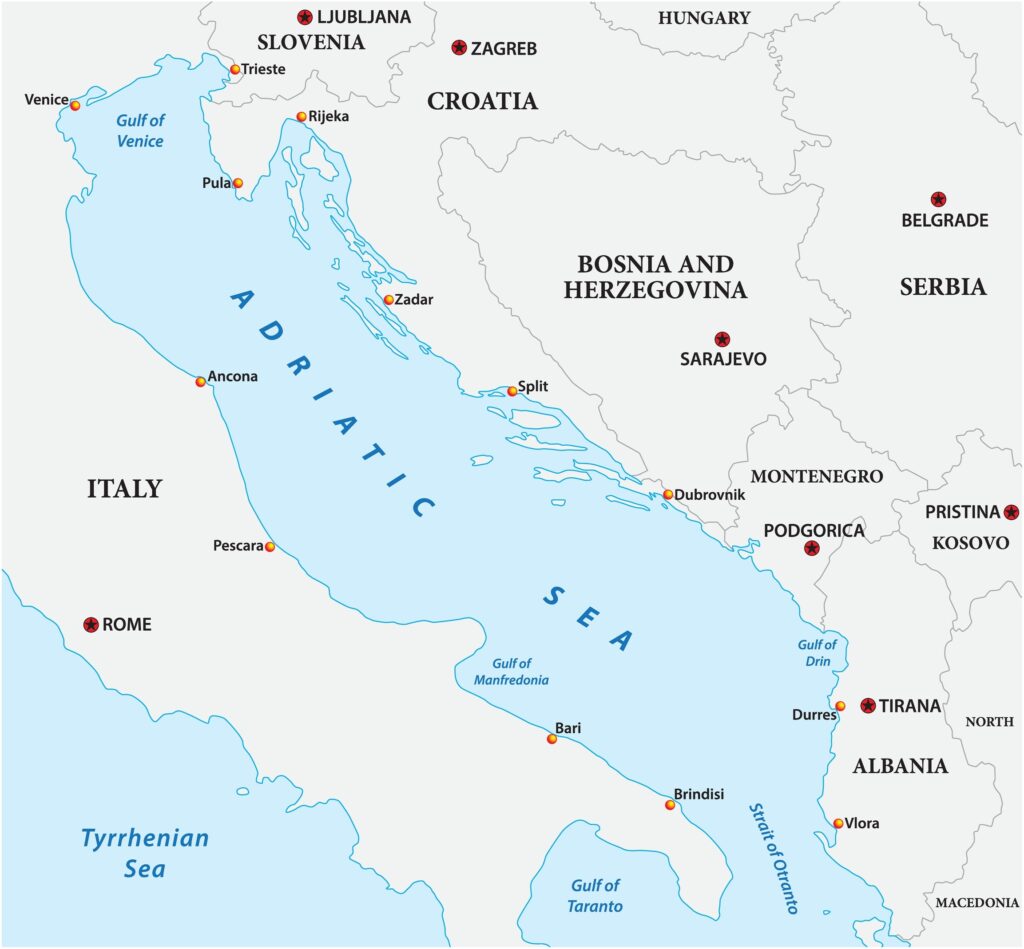
Countries on the Adriatic Sea:
- Italy
- Slovenia
- Croatia
- Bosnia & Herzegovina
- Montenegro
- Albania
Italy
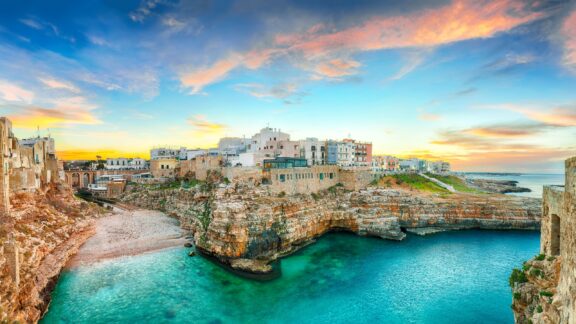
Capital city: Rome
Population: 58.85 million (2023 estimate)
Official language: Italian
Italy is perhaps the most renowned of the countries on the Adriatic Sea. It’s especially known around the world for its food and cultural legacy. Italy’s coastline along the Adriatic Sea stretches from the toe of its boot-shaped peninsula up to the northern part of the country. In fact, the entire eastern edge of the Adriatic borders Italy.
History
The Adriatic Sea has played a very important role in Italy’s history. The region of Veneto, home to Venice, was a major center of trade and commerce during the Middle Ages, and cities like Bari in its southern region served as significant ports. Italian ports played a central role in linking the eastern and western Mediterranean.
Geography
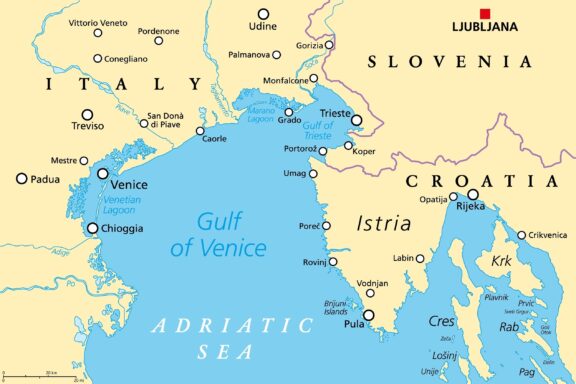
The Adriatic coast of Italy is characterized by sandy beaches, limestone cliffs, and iconic towns. The Po Delta, near the northern end, is a unique wetland area that provides habitat for numerous bird species.
Italian Landmarks
It’s not as famous as the country’s western coast, but maybe it should be. Italy’s Adriatic coastline is dotted with numerous landmarks that testify to its historical and cultural richness.
Venice, the city famous for its canals, hosts many incredible landmarks, including its Grand Canal, St. Mark’s Basilica, and the historic Doge’s Palace.
Further south, the Basilica di San Nicola in Bari serves as an important pilgrimage site, holding the relics of Saint Nicholas.
Slovenia
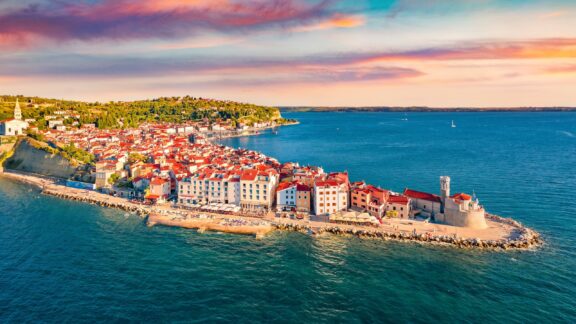
Capital city: Ljubljana
Population: 2,116,972 (2023)
Official language: Slovene
Tucked between Italy, Croatia, Hungary, and Austria, Slovenia has the shortest coastline on the Adriatic. It’s one of Europe’s younger nations, gaining independence from Yugoslavia in 1991, and exhibits qualities of Central Europe in combination with a Mediterranean flair.
History
The history of Slovenia involves a mixture of various influences, from ancient Roman settlers to the Habsburg Monarchy. The country’s Adriatic coastline, though small, played a crucial role in maritime trade, especially during the era of the Venetian Republic.
More recently, the achievement of Slovenia’s independence after the breakup of Yugoslavia in 1991 marked a pivotal point in the formation of its current identity.
Geography
Despite having only a 46.6 km (29 mi) stretch along the Adriatic Sea, Slovenia’s coast is a picturesque blend of lagoons, cliffs, and quaint coastal towns.
Slovenia is mostly mountainous and forested, and the backdrop of the Julian Alps in the distance contrasts with the sea’s azure blue, creating landscapes that have inspired many.
Slovenian Landmarks
The coastal town of Piran stands out as an architectural gem on Slovenia’s Adriatic coastline, reflecting Venetian Gothic architecture reminiscent of its historic ties to the Venetian Republic. Tartini Square, named after the famous violinist and composer Giuseppe Tartini, serves as the town’s heart.
Not far from Piran, the Škocjan Caves, a UNESCO World Heritage site, offer a unique underground tour of one of the world’s largest known underground canyons.
Croatia
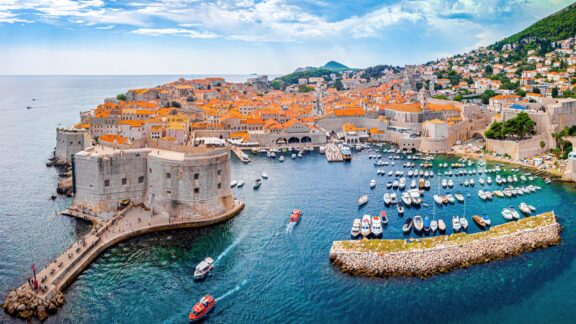
Capital city: Zagreb
Population: 4,169,239 (2023 estimate)
Official language: Croatian
Croatia is a Balkan nation that is renowned for its island-marked seascape, ancient port towns, and sun-drenched beaches. This country is a major part of the Adriatic sub-region as it has the longest coastline on the Adriatic and the third-longest Mediterranean, measuring 1,777 km (1,104 mi).
History
Croatia’s Adriatic coast has been a coveted prize for many empires over the centuries. From the Roman ruins in Split and Pula to the medieval walls of Dubrovnik, each era has left its mark.
The coastal cities, particularly those like Ragusa (now Dubrovnik), were significant maritime republics that rivaled Venice in trade and influence during the Middle Ages.
Geography
Not only is the country’s coastline long, it’s diverse. It ranges from flat, sandy stretches in the northern Croatian county of Istria to the rugged Dalmatian cliffs further south. But perhaps the most distinctive feature is the over 1,000 islands and islets that dot the seascape, each boasting its unique character, from the party vibes of Hvar to the serene nature havens of Mljet.
Croatian Landmarks
Dubrovnik, often referred to as the “Pearl of the Adriatic,” with its UNESCO-listed Old Town, is arguably the country’s most iconic coastal landmark. It was made even more famous when the hit series, Game of Thrones, was filmed in the city.
Other Croatian landmarks include Diocletian’s Palace in Split, the amphitheater in Pula, and the stunning Plitvice and Krka National Parks.
Bosnia & Herzegovina
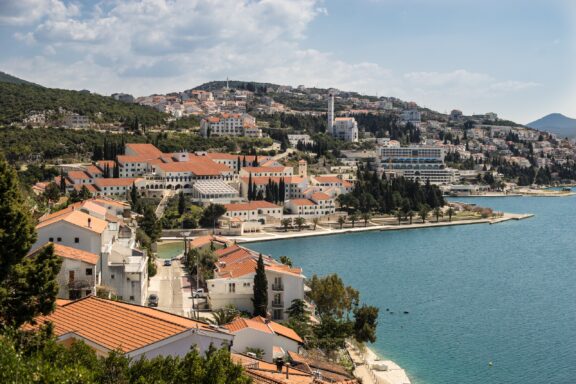
Capital city: Sarajevo
Population: 3,807,764 (2023 estimate)
Official language: Bosnian, Croatian, and Serbian
Bosnia and Herzegovina, often simply referred to as Bosnia, is predominantly landlocked, but its brief 20-kilometer stretch along the Adriatic Sea is significant all the same. The coastal strip surrounds the city of Neum, the only Bosnian city on the Adriatic and its one link to the sea.
History
The strategic position of Bosnia’s coastal Neum has made it a historically significant port and a contested area among neighboring territories. The Ottomans and Austro-Hungarians have both occupied the area, each adding to its blend of cultures.
Though its Adriatic footprint may be small, Bosnia’s coast has still played a role as an intersection of diverse cultures and influences.
Geography
Bosnia’s Adriatic coastline is centered around Neum, which is located on a bay shielded by rugged hills. This forms a natural harbor, which makes it a valuable territory. The interior of Bosnia is dominated by mountains and forests, which contrast with the coastal region and are full of impressive landscapes.
Bosnian Landmarks
In addition to its role as a beach destination, Neum’s architecture and local culture provides visitors with a reflection of the country’s eclectic history, something on display in the Old Town of Neum.
The coastal region is also in close proximity to sites such as the UNESCO-protected Stari Most (Old Bridge) in Mostar and Hutovo Blato Nature Park.
Montenegro
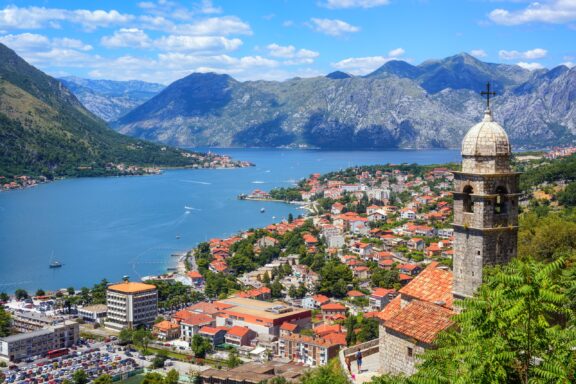
Capital city: Podgorica
Population: 602,445 (2023 estimate)
Official language: Montenegrin
Montenegro is a small Balkan country that gained independence as recently as 2006 and is named for its “Black Mountains.” The country’s dramatic mountain landscapes combine with beach resorts and medieval towns to create an environment that is culturally rich and naturally beautiful.
History
Montenegro’s location in the Balkans with access to the Adriatic Sea has made it a sought-after territory and intersection for trade, culture, and conquest for thousands of years. It was at one time part of the Roman province of Dalmatia, later to become part of the Republic of Venice.
It was then controlled by the Ottomans before becoming part of Yugoslavia and eventually gained independence in 2006.
Remnants of Montenegro’s history can be seen in the fortified towns that still stand along its shores.
Geography
Montenegro’s coast is a mix of sandy coves and rugged cliffs, interspersed with tranquil bays. The Bay of Kotor, a winding bay of the Adriatic Sea, is often mistaken for a fjord due to its steep, mountainous terrain and calm waters.
Further inland, Montenegro’s landscape features some of the most rugged mountain terrain in Europe. Its borders with Serbia, Kosovo, and Albania are lined with high peaks.
Montenegrin Landmarks
The town of Kotor is one of the most popular places to visit in Montenegro and is renowned for its well-preserved old town and UNESCO-listed fortifications.
Further south, Budva is famed for its vibrant nightlife, sandy beaches, and the historic Stari Grad (Old Town) surrounded by Venetian walls.
Albania
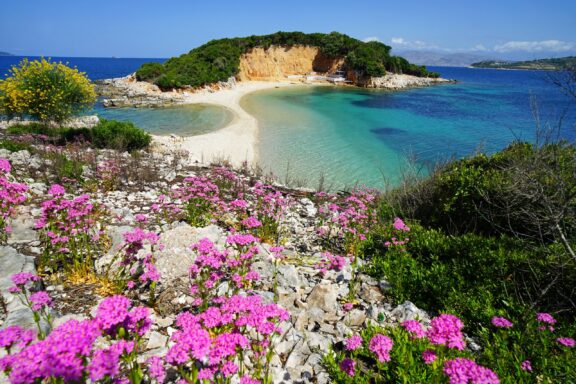
Capital city: Tirana
Population: 2,761,785 (2023)
Official language(s): Albanian
Nestled between Montenegro to the north and Greece to the south, Albania has steadily emerged from its historically isolated stance to become a major part of the Adriatic region. The country features untouched beaches, ancient ruins, and a warm, hospitable culture.
History
Albania’s coast has seen many civilizations come and go, from the ancient Illyrians to the Romans, Byzantines, and Ottomans. The city of Durres, once known as Dyrrachium, was a significant port during the Roman era and played a pivotal role in various military campaigns.
Geography
The country’s northern coastline along the Adriatic boasts sandy beaches and flat terrain, transitioning to the more rugged and dramatic cliffs of the Ionian Sea in the south. The country is also home to the remarkable Llogara Pass, a mountainous backdrop to the surrounding blue seas.
Albanian Landmarks
The ancient city of Butrint, a UNESCO World Heritage Site, offers a journey through millennia, with remnants from Hellenistic, Roman, Byzantine, and Venetian times.
Ksamil, with its pristine beaches and turquoise waters, is often touted as the Albanian Riviera and is a favorite vacation spot for foreigners and locals alike.
FAQs: More About Countries on the Adriatic Sea
How many countries border the Adriatic Sea?
There are six countries that border the Adriatic: Italy, Slovenia, Croatia, Bosnia and Herzegovina, Montenegro, and Albania.
Is the Adriatic Sea part of the Mediterranean Sea?
Yes, the Adriatic Sea is a northeastern arm of the Mediterranean Sea, separating the Italian Peninsula from the Balkan Peninsula. It is also connected to the Ionian Sea.
What are the main economic activities along the Adriatic coast?
Historically, trade and maritime commerce have been pivotal. Today, tourism, fishing, and maritime trade remain important activities. Many coastal cities are major tourist attractions.
Which countries on the Adriatic Sea were once part of Yugoslavia?
Slovenia, Croatia, Bosnia and Herzegovina, and Montenegro were all part of the former Yugoslavia.
How many islands are there in the Adriatic Sea?
There are over 1,000 islands in the Adriatic Sea, mostly located near its eastern shores. The majority of these islands are uninhabited and belong to Croatia.
Image Sources and Copyright Information
- Map of the Adriatic Sea and Surrounding Countries: © Rainer Lesniewski/Shutterstock
- Breathtaking Sunset Over Cala Paura Gulf with Historic Buildings in Italy: © Vadym Lavra
- Gulf of Venice and Surrounding Regions Map: © Peter Hermes Furian/Shutterstock
- Aerial View of a Coastal European Town at Sunrise: © Andrew Mayovskyy
- Aerial Panoramic View of the Historic Walled City of Dubrovnik on the Coast of Southern Croatia: © Alexey Fedorenko/Shutterstock
- Scenic View of Neum, the Coastal Town in Bosnia and Herzegovina: © HUANG Zheng/Shutterstock
- Panoramic View of Kotor Old Town and Bay Against a Mountainous Backdrop: © Boris Stroujko/Shutterstock
- Serene Twin Beaches on a Sunny Day in Ksamil, Southern Albania: © eyetravelphotos/Shutterstock